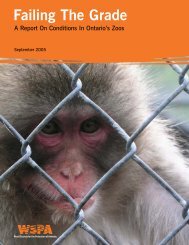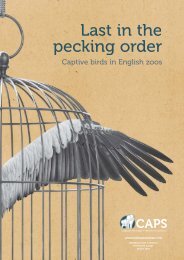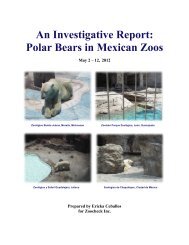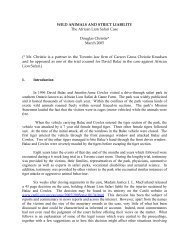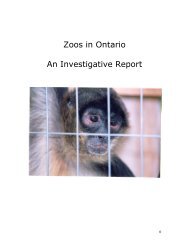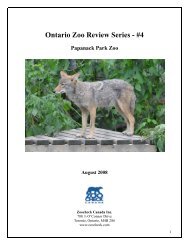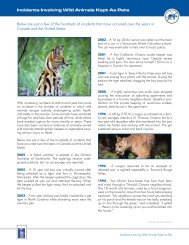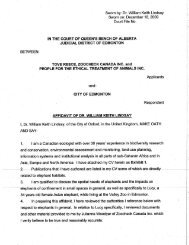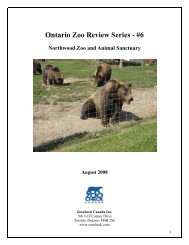STATUS OF BEAR WELFARE
STATUS OF BEAR WELFARE
STATUS OF BEAR WELFARE
Create successful ePaper yourself
Turn your PDF publications into a flip-book with our unique Google optimized e-Paper software.
Status of Bear Welfare in Cherokee, North Carolina<br />
DAILY HUSBANDRY<br />
The daily keeper routine at CSBP and CBZ is uncertain, but there was evidence that the routine<br />
did not differ from the age-old “clean ‘em, feed ‘em, and lock ‘em outside” routine. The basic<br />
routine was as follows:<br />
• The outside enclosure is hosed down for cleaning.<br />
• It is probable that the bears are not given breakfast so as to enhance their need to “beg” for<br />
food from the zoo patrons.<br />
• The bears are locked outside on exhibit.<br />
• The off-exhibit cages and underground catacombs are hosed down or shoveled out at some<br />
point during the day when it is convenient for the caregiver.<br />
• The bears spend the day exhibiting aberrant behavior, either begging for food or pacing.<br />
• The bears are locked in after closing hours.<br />
The bears were likely being locked in at night. This compounds their problems even further, as<br />
they will be even more deprived of stimulation than they are in their day exhibit. If the facility’s<br />
hours are from 9 a.m. to 9 p.m. on a summer day, this means that the bears spend 12 hours<br />
exhibiting aberrant behaviors in the pit and 12 hours in the cages underground or off-exhibit<br />
without proper sunlight and stimulation. If the facilities shorten their operating hours during the<br />
weekdays after Labor Day (from 9 a.m. to 6 p.m.), it means that the bears spend nine hours<br />
exhibiting aberrant behaviors in the pit and 15 hours in the holding cages without proper sunlight<br />
and stimulation. It is likely that these bears have also developed regular pacing patterns in the<br />
indoor or underground cages. If this routine were imposed on humans or even canine<br />
companions, we would consider it extremely inhumane.<br />
There was no evidence of straw or any other bedding materials for the bears and no digging beds<br />
or leafy browse for making day beds. Evidence of bedding given to the bears in the indoor<br />
enclosures would likely have made its way out into the outdoor enclosures in the bear’s fur, but<br />
no bits of straw hay or wood wool were observed. It is unlikely that these bears were being given<br />
bedding of sufficient quantity and appropriate material or possibly even any bedding at all.<br />
At SL, it seemed that the full extent of the husbandry is simply feeding, cleaning, and leaving the<br />
animals alone, with the exception of the three public bear cub feedings. Furthermore, the straw in<br />
the metal drum in the bear cub enclosure was old and soiled and was not being replaced with<br />
fresh, clean straw at appropriate intervals.<br />
SEASONAL HUSBANDRY<br />
Captive bears, whether or not they are given the opportunity to den, go through seasonal<br />
biochemical changes. If they are not given the opportunity to den, they can become shorttempered,<br />
confused, and slower in their responses to their environment. It is similar to sleep<br />
deprivation. Denning also serves an important biological function of renewal for the bear. These<br />
effects are not yet fully understood by scientists, but they include, for instance, foot pad<br />
sloughing. 9 Although in warmer climates there are a few bears who choose not to den, each wild<br />
bear has the freedom to assess his or her own biochemistry and has the ability to determine<br />
whether or not to go through a winter without denning.<br />
AN INVESTIGATIVE REPORT <strong>OF</strong> CHIEF SAUNOOKE <strong>BEAR</strong> PARK, CHEROKEE <strong>BEAR</strong> ZOO, AND SANTA’S LAND | 28





